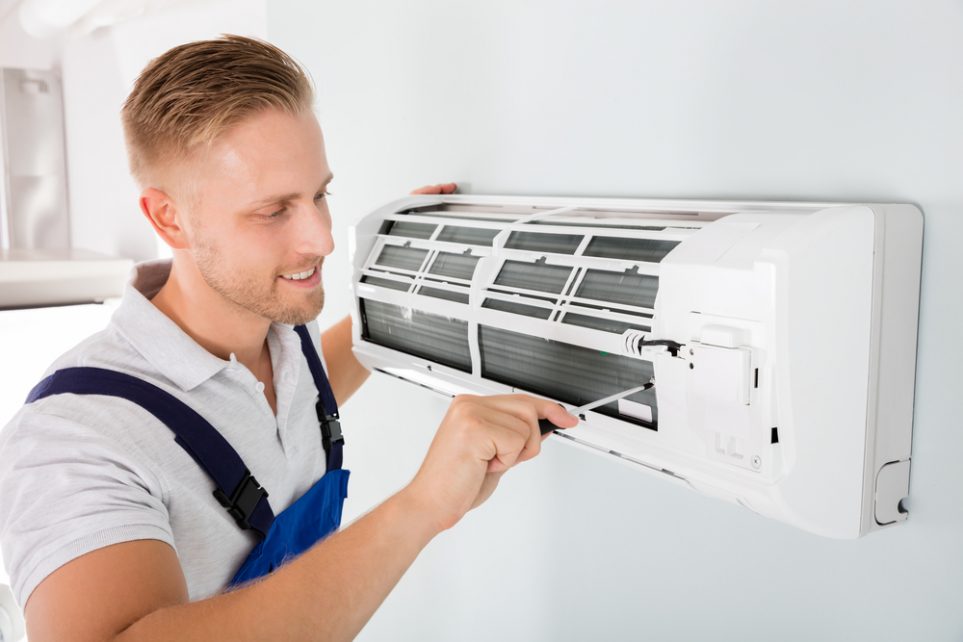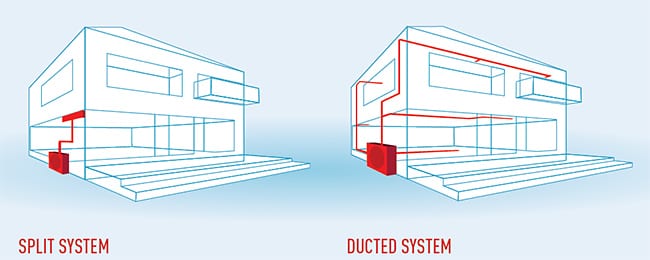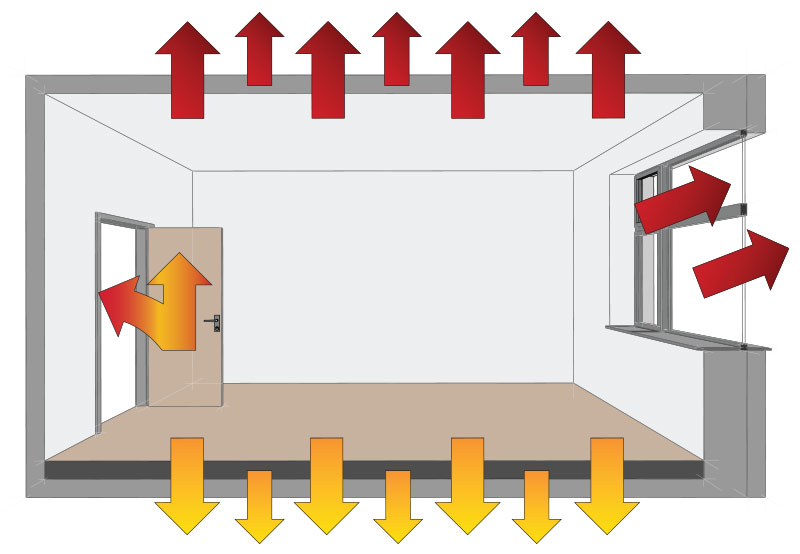Buying The Correct Air Conditioner


Exactly what type of air conditioning system you use depends on what you’re trying to accomplish. So how do you know which one is best for you when buying the correct air conditioner ?
The simplest air conditioner that’s commonly used in Australia is the single split system. This is where you have an outdoor unit, and a single separate indoor unit. The indoor unit is sometimes referred to as a fan coil. The fan coil is usually mounted high up on a wall where you can see it.
This type of device is suitable for a single room. If you’re conditioning an entire house, you’d use a larger system.
A single ducted system has an outdoor unit, and a single indoor fan coil unit. The fan coil is mounted in a ceiling cavity or somewhere else where it’s concealed from view.
The fan coil then has a number of flexible ducts which connect the outlet to various ceiling-mounted air diffusers. There will also be a return air grille with ducting back to the fan coil.
Placement of the air diffusers is important. Most bedrooms will have a single diffuser. Large rooms, like a living room, will probably have more. Wet areas like bathrooms and laundries won’t have any, because if they did it would push the wet air in those rooms back through the house. Wet areas will normally have their own mechanical exhaust (an extract fan) but no air conditioning.
There will normally be a single return air grille, and this is normally in a hallway or some central common area. Often, the return air grilles don’t look quite so appealing, so we try to keep them away from view. This is where air form inside the house gets drawn back up into the air conditioning system.
Ducted systems are usually the most cost-effective type of air conditioning. The main drawback in the context of architectural homes is that you need enough space to fit all the ducts in the ceiling. With many architectural house designs, there’s not enough space for ducts. In that case, we need to look at multi-split systems.
 Split multi-head systems
Split multi-head systemsThese types of air conditioning systems are popular in townhouses or architecturally designed homes which don’t have much ceiling space. This can happen when you have a flat roof, or a low-profile design.
A multi-split system is the same as a single split system but it has multiple indoor units connected to a single outdoor unit. The indoor units can be wall-mounted fan coils, but are more commonly concealed in a bulkhead, or hidden in some joinery such as above a wardrobe or kitchen cabinets. Basically, each room has its own separate air conditioning unit.
The visible part of the concealed bulkhead units is just a linear grille. The return air path is usually through the same grille, so there’s no separate supply and return grilles. This keeps the visual impact to a minimum, but depending on how the house is designed it can mean a compromise in system performance.
These types of systems are sometimes called a Variable Refrigerant Flow system (VRF).
As a guide, for typical 4-5 bedroom houses, a multi-split system will cost around $10,000 more than a ducted system. So it’s almost always more cost-effective to use a ducted system if you have the space available.
How big your air conditioning system should be is as much art as it is science.
It can be a tricky question because “thermal comfort” is very much personal preference. What one person think is too hot or too cold, another person might think is just right. We’ve all had the experience of walking down the street shivering under our coats and scarves on a cold day only to see another person out for a walk in a t-shirt and shorts.
Despite that, there are a few rules of thumb to appropriately size an air conditioning system for your home.
The first thing to consider is the “cooling load” for each room. Basically, this tells you what size air conditioner you need in each room. The size of an air conditioner is measured in units called Kilowatts. Think of this like ‘horsepower’ for a car engine – more kilowatts equals a more powerful air conditioner.
The basic rule of thumb for sizing air conditioning is 100 Watts per square metre of floor area. This is a rough guide, but it applies in most Australian cities.
This assumes that you have a typical floor-to-ceiling height of 2.4m-2.7m. If your ceiling is much higher than this, you might have to add a bit more – maybe 25% to the cooling load to account for the extra space to be cooled.
So as an example, a 50 m2 bedroom with a 2.7m ceiling would need approximately 5000 Watts, or 5 Kilowatts.
Any room in your house that gets direct sunlight during the day will tend to overheat. So those are the rooms with the highest cooling load. Think about any room with large, north-facing windows – in the southern hemisphere, the sun is always to the north.
Rooms with east and west facing windows will get morning and afternoon sun respectively. Morning overheating is not always a problem, as that’s the coolest part of the day and it takes a while to warm up. However west facing glass will get afternoon sun, which is usually the hottest part of the day so overheating in the afternoon is almost always a problem.
As we discussed before, a suitable air conditioning load is about 100 Watts per square metre (W/m2) of floor area in the room. For living rooms with a large amount of north or west facing glass, you may need as much as 150W/m2.
As an example, a 80 m2 living room with large, north-facing windows would need approximately 150W x 80 m2 = 12,000 Watts, or 12 Kilowatts.
Some areas in the house won’t need air conditioning, so we don’t include them in the calculation.
Wet areas such as bathrooms and laundries shouldn’t have any air conditioning. These rooms are not usually occupied most of the time, and bathrooms in particular usually have their own heating.
Also keep in mind that a ducted air conditioning system will cause air to circulate around the house as it gets drawn up into the AC unit and then blown back through the vents. If you have an outlet in a bathroom or laundry, any odours in those rooms will be carried along with the air and spread through the whole house – not ideal.
Garages normally aren’t conditioned for the same reason, plus garage doors aren’t usually airtight so any heating or cooling in the garage gets lost to outside easily.
Utility areas like hallways don’t need to be included in the calculations.
Once you have the air conditioning requirements for all the rooms in your house, simply add them together to get the total load.
 Diversification – keeping costs down
Diversification – keeping costs downOf course you can just install an air conditioning system big enough to cool every room in your house at the same time, but remember that a bigger AC unit will cost more to install and to run.
A common trick in the industry to keep costs down is to size the air conditioning system for day & night zones. This assumes that you’ll either be using the AC for your living areas or your bedrooms, but not both zones at the same time.
For instance, if you worked out that your living areas needed 10kW and your bedrooms required another 10kW, you could install a 20kW system. Or, if you knew that you probably wouldn’t need to use every room at the same time, you could put in a 15kW system which would be big enough almost all of the time. If you ran both zones at the same time then the total output would be lower.
This is where personal preference enters the equation. If you’re the sort of person who likes your air conditioning ice cold and you’re really not a fan of hot and humid days, then you might need to go for the full size system.
If you’re not too fussed and content to just open a window, then the smaller unit might be a better choice.
Image Credit : (Split vs Ducted Air Conditioning) Panasonic
Credit : Luxury Heating & Cooling